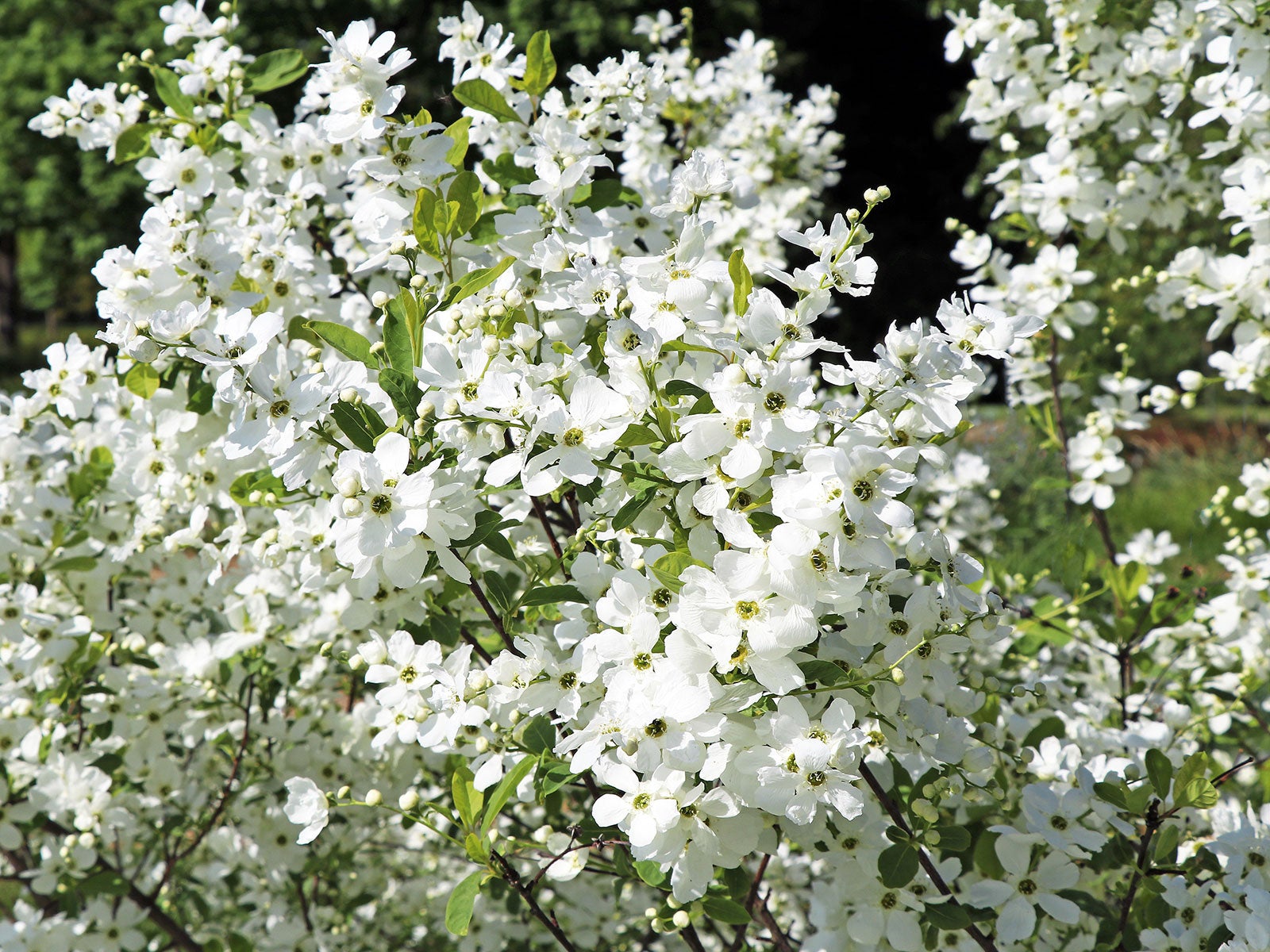Grow Pearlbush: Discover Exochorda Racemosa


When you grow pearlbush, you are adding a flourish of rare beauty to your garden. With its brilliant white flowers, this shrubs makes a beautiful plant for a border or hedge. Common pearlbush (Exochorda racemosa) is known for its dazzling display of bright white flowers in early spring. These flowers blossom from pearl-shaped buds which gives this shrub its name.
Grown with care, this is one of the best flowering shrubs you can grow. It is rarely bothered by pests and diseases. Furthermore, if you grow dwarf cultivars, it is very manageable in a small yard.
Quick Pearlbush Facts:
- Botanical name: Exochorda racemosa
- Height: 10 to 15 feet (3-4.6 m)
- Spread: 10 to 15 feet (3-4.6 m)
- Sun exposure: Full sun to part shade
- Soil requirements: Prefers acidic, well-draining, fertile loam
- Hardiness zones: USDA 4-8
- When to plant: Plant in fall for spring bloom
How To Grow Pearlbush
Common pearlbush forms a rounded shape, so it is suitable for a foundation, hedge or shrub border. If you need bright white flowering shrubs that make a statement, pearlbush works well in more ornamental borders. Pearlbush is native to China and is a member of the rose family, closely related to spirea plants.
Its five-petaled, cup-shaped flowers are 1.5 inch (4cm) in diameter. They are borne on racemes against green, oblong leaves. The flower buds develop on the previous year’s growth. Cultivars typically produce larger blooms than common pearlbush. Flowers give way to persistent, brownish-green, star-shaped seed capsules.
Best Care for Pearlbush
You can grow pearlbush quite easily. It’s a low-maintenance plant that is rarely bothered by pests or disease. Here are the main attributes of pearlbush care:
Light & Warmth
Pearlbush does best in full sun though it will tolerate light shade. Make sure these shrubs receive at least six hours of sunshine every day. They tolerate heat and humidity well.
Water & Fertilizer
Water your pearlbush plant regularly, at least once a week. Once established, it can tolerate drought. You won't need to feed frequently. Just add a little organic matter at planting time for a fertile soil.
Gardening tips, videos, info and more delivered right to your inbox!
Sign up for the Gardening Know How newsletter today and receive a free copy of our e-book "How to Grow Delicious Tomatoes".
Soil Preferences
Plant pearlbush in rich, loamy, acidic soil that is well draining. It may help to raise the acid level in soil before planting. Although acidic is the ideal, this shrub will tolerate average, alkaline or clay soils.
Problems, Pests & Diseases
Pearlbush usually is not bothered by pests and disease. If you have any issues with this shrub, it will be with aphids. Control any aphid outbreaks with beneficial predators like lacewings and ladybugs.
How to Plant a Pearlbush
Plant pearlbush in fall so it will be established by springtime. These shrubs do best in a well-drained corner of the garden. Make sure the planting site is permanent, because pearlbush has a long taproot and is difficult to move.
Pearlbush Pruning
Prune a pearlbush for size and shape, immediately after flowering, as it blooms on old wood (last year’s growth). These plants can tolerate a severe rejuvenation pruning if overgrown, so don't be afraid to cut back hard if required. Remove dead or damaged wood at any time. An annual pruning helps to maintain overall growth and makes the shrub easier to manage.
Propagating a Pearlbush
Propagation is prohibited in patented cultivars. For common pearlbush, propagate by cuttings or seed. You can root softwood cuttings in midsummer. Cut 3-6in (8-15cm) stems and remove lower leaves. Plant in moist perlite or potting soil and cover with a plastic bag or dome. Keep soil moist, but not wet, until roots form. A warming mat is helpful. Seeds need stratification, so plant in a seedbed outdoors in fall.
Recommended Pearlbush Varieties
Your available space will have some bearing on the variety you grow. Common pearlbush shrubs may be too large to grow as hedge plants. However, specially bred cultivars grow 3 to 6 feet (1-2m) tall. This makes them better for hedging and borders. Try these varieties:
- 'The Bride' (Exochorda x macrantha) – This shrub grows about 4ft tall (1.2m) and has a weeping habit.
- Snow Day 'Surprise' (Exochorda 'Niagra') – 'Surprise' stands upright at 4-5ft (1.2-1.5m). It develops large flowers.
- Snow Day 'Blizzard' (Exochorda racemosa hybrid) – This variety reaches 5-6ft (1.5-1.8m) tall. It grows large flowers in a mounded habit.
- 'Lotus Moon' (Exochorda x macrantha 'Bailmoon') – 'Lotus Moon' grows 4-5ft tall (1.2-1.5m) with an upright habit.
Frequently Asked Questions
How Big Can Pearlbushes Get?
Common pearlbush can reach 10-15ft (3-4.6m) tall and wide, depending on location, growing space and nearby plants. Dwarf cultivars reach 4-6ft (1.2-1.8m) tall and wide.
Is Pearlbush an Evergreen?
Pearlbush is a deciduous shrub with a loose, broad habit. So you may see some leaf fall in winter. If leaves drop in summer, it may just need watering or a little liquid feed.

After graduating from Oklahoma State University with a degree in English, Susan pursued a career in communications. In addition, she wrote garden articles for magazines and authored a newspaper gardening column for many years. She contributed South-Central regional gardening columns for four years to Lowes.com. While living in Oklahoma, she served as a master gardener for 17 years.
-
 8 Noteworthy Native Azaleas Every Gardener Should Know – And Grow!
8 Noteworthy Native Azaleas Every Gardener Should Know – And Grow!Native azaleas offer brilliant blooms in a range of colors and sizes. Here are a few favorites to get inspired and start working on a native shade garden!
-
 Growing Climbing Roses: How To Create Elegant Displays With Maximum Blooms
Growing Climbing Roses: How To Create Elegant Displays With Maximum BloomsMaster the art of growing stunning climbing roses with this essential guide to creating vibrant, fragrant walls and structures all summer long.